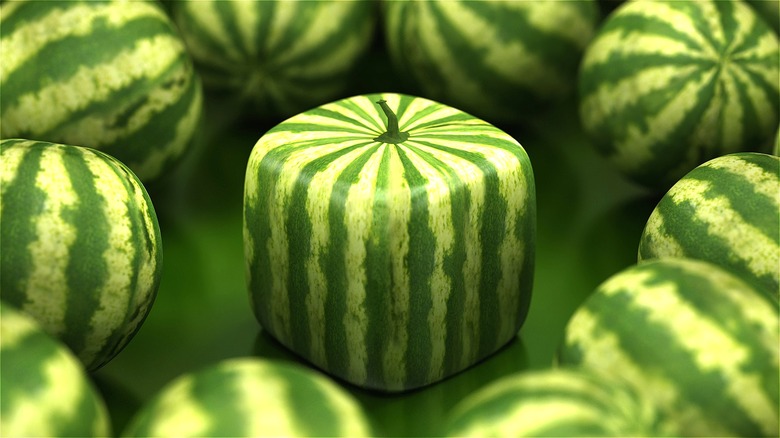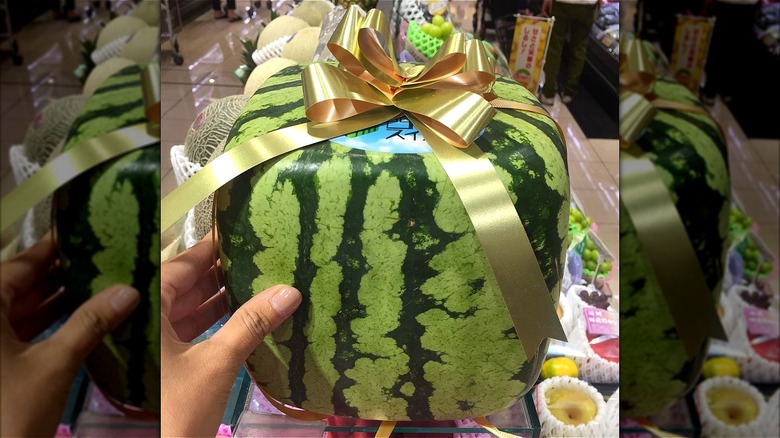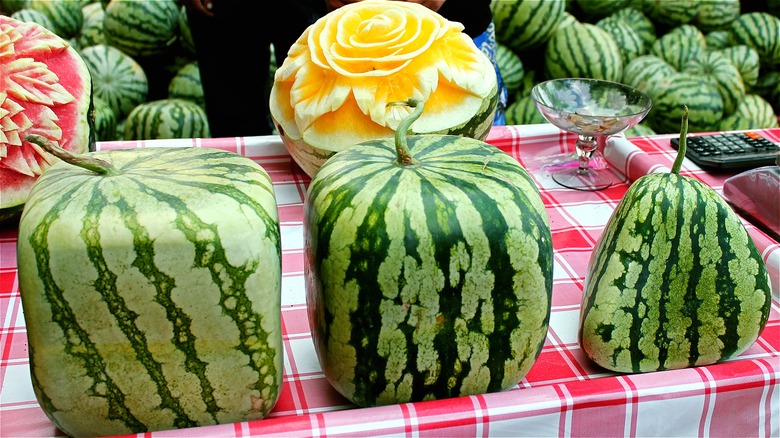Japan's Wildly Expensive Square Watermelons Aren't Even Edible
While Japan may be widely known for delicious dishes like grilled chicken ramen and miso soup, who knew it was also responsible for cultivating pricey, square-shaped watermelons? Sure enough, in the city of Zentsuji in Kagawa prefecture on the island of Shikoku, farmers take special care to grow Stripe King watermelons in plastic or glass vessels until they mature to an unconventional square shape. These specially grown melons are nearly impossible to find in the U.S. and, depending on where they're purchased in Japan, cost anywhere between $65 to more than $500 when you factor in size and availability. They're also entirely inedible. So why the high price point for a melon you can't even eat? And why grow it in the first place? The answer is complicated.
The high price tag of Zentsuji square watermelons is a direct reflection of the work required to produce these specially-sized fruits. The process of adequately caring for and harvesting square-shaped melons is laborious and time-consuming. Young oval-shaped watermelons are placed in clear glass or acrylic boxes made strategically smaller than fully-sized watermelons. As the fruit matures, it begins to form in alignment with the shape of the container.
However, farmers must consistently monitor growth to ensure the watermelons grow at the right speed and showcase perfect vertical stripes along the rind. Due to the finicky growing process, only 200 cube-shaped watermelons are produced and sold each year. To fully understand the high price point of these melons and their relation to Japanese culture, you need to know why (inedible) square-shaped watermelons were developed in the first place.
How square watermelons became prized inedible gifts
As far as seasonal summer produce goes, watermelon is one of the most popular options. However, with the development of more commercialized treats in Japan in the late 1960s, one watermelon farmer wanted to combat this new competition by adding a specialty item to his line of standard produce. With careful development, 18-centimeter cube-shaped watermelons entered the retail market in Japan in the late 1970s. Not only were these melons easier to transport, but square-shaped watermelons were also easier to cut and proved to be just as delicious as their oval-shaped cousins.
Unfortunately, ripe watermelons, round or square, don't last more than 10 days at room temperature. Japanese consumers became resistant to paying top dollar for cube-shaped melons that had to be consumed within a specific time frame. Therefore, these pricey fruits were re-cultivated and eventually re-branded as luxury gifts. You can attribute the high cost of cube-shaped watermelons to their exemplary status in the Japanese retail market.
Square watermelons are now exclusively sold as decorative symbols to represent status and wealth in Japanese culture. They even serve as visual displays in department stores and high-end supermarkets. Once a perfectly edible cube-shaped fruit, square watermelons sold in Japan are now completely inedible. They are harvested before ripening to preserve their deep green appearance and shelf-life. While paying up to $200 for an inedible watermelon may seem questionable, there are even pricier options available exclusively in Japan.
Japan produces several more expensive melon varieties
Next to cube-shaped melons, Japan also produces heart-shaped watermelons that, depending on their size, cost anywhere between $200 to $350. For even more dedicated buyers, there are also watermelons grown and molded into the shape of pyramids and human faces, all costing between $500 and $600. While there may be locals willing to shed their hard-earned dollars for a square or heart-shaped watermelon, those living outside the bounds of Japan have to pay a lot more to score one of these perfectly square fruits.
People living outside of Japan may be charged closer to $800 for one square watermelon after shipping and handling. Unless you see this specially-shaped watermelon as a necessary decoration for your home, going out of your way to pay exorbitant prices for one watermelon may not seem worth the cost or effort. However, if you find yourself in Japan and want to see these rare fruits for yourself, check upscale department stores in areas near Osaka or Tokyo.
Luckily, there are luxury fruits you can order directly from Japan that are actually edible. Both Japanese crown and raiden melons cost upward of $100 through specialty websites. While you still might be able to apply your favorite creative watermelon ideas to these exclusive varieties, be prepared to pay top dollar. As for square watermelons, unless you're in Japan, you won't be seeing these novelties in major stores anytime soon.


